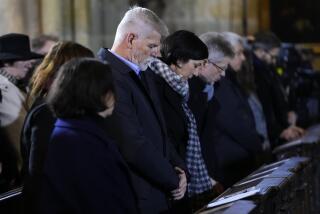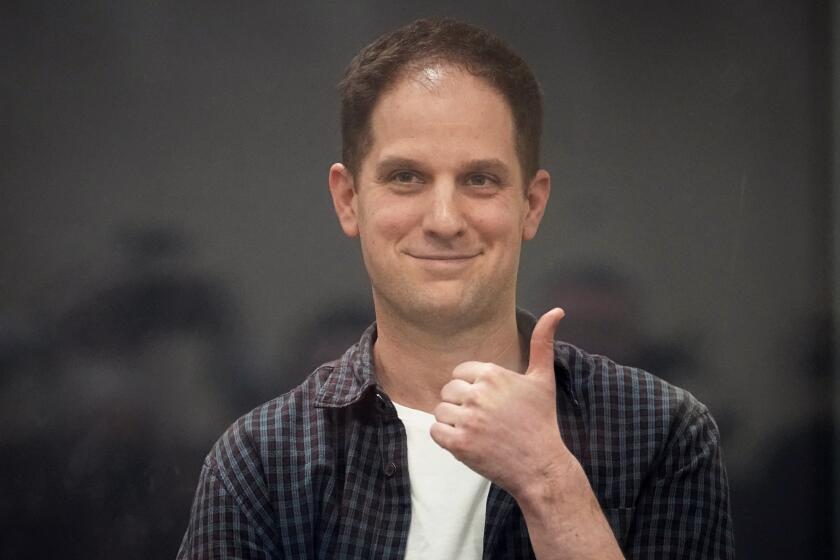From the archives: Troops Fire Into Crowds in Romania
WARSAW -- Security forces armed with automatic weapons fired into crowds of protesters in the Romanian capital of Bucharest on Thursday, killing or wounding an undetermined number of demonstrators demanding an end to the rule of dictator Nicolae Ceausescu.
A reporter for Tanjug, the Yugoslav news agency, said several thousand demonstrators, mainly schoolchildren and university students, were surrounded by police and tanks at a main intersection near the Inter-Continental Hotel in the center of Bucharest. Peter Tomic, a Yugoslav journalist, said he saw an armored vehicle crush two students. When others rushed to their aid, security forces opened fire, killing or wounding about 20 people.
In Washington, the State Department quoted U. S. Embassy officials in Bucharest as saying that at least 13 young people had been killed in the demonstration just two blocks from the embassy. Budapest Radio reported 32 more demonstrators were killed in the northern city of Cluj.
The Soviet news agency Tass reported at midnight that the sounds of gunfire from automatic weapons could still be heard echoing in the center of the capital.
“There is light in all the windows of buildings in the areas where the demonstrations are under way. People have come out onto balconies and some of them are shouting slogans supporting the protests,” the report added.
Reports on the second assault on unarmed civilians in five days came mostly from such East Bloc news organizations, among the few foreign news services reporting from Romania, which has been sealed off to foreigners since Monday, as the Ceausescu regime faced what could be its terminal crisis after 24 years in power.
Gunfire was also reported to have broken out at a demonstration in the city of Arad in western Romania, about 40 miles from the western city of Timisoara, where security forces opened fire on demonstrators Sunday. Estimates of the death toll in Timisoara range from a few hundred to as high as 4,000, but there has been no independent confirmation of the casualties. Even East Bloc journalists, attempting to reach Timisoara, have been turned back from the town.
The Tanjug correspondent, reporting on Belgrade Radio, said the confrontation in Bucharest had turned into a “bloody riot.”
Before its midnight report, Tass said, “Along the central street of the capital, tanks are moving, following the lines of submachine gunners pushing back the crowds. Bursts of automatic weapons fire are being heard. Panic-stricken people are hiding in doorways and courtyards.”
Tass added that “a great many fire brigade trucks and military trucks with personnel are being concentrated in the central part of the Romanian capital,” and approaches to Communist Party headquarters and Ceausescu’s presidential palace were blocked by heavily armed army units.
Tass reported that students had gathered late into the night on the grounds of the university and had called for a general strike today. It said the students claimed to have sent representatives to factories to urge workers to join the strike. It added that anti-government leaflets have appeared on walls in the city.
Ceausescu, 71, whose disregard of human rights has ranked him among the most notorious dictators on the globe, told Romanians in a speech Wednesday night that the demonstrations in Timisoara were inspired by “fascists” and “international espionage centers.”
He issued no warnings about further action against demonstrations, but defended the actions of security forces in Timisoara.
With the country so effectively sealed off, accounts of the Timisoara events have come only at a trickle and are of uncertain reliability. But some of them begin to suggest that Ceausescu may be facing a problem in keeping army and police units loyal to his cause.
A Yugoslav newspaper reported that a truck driver, returning to Yugoslavia from Timisoara, said security officers publicly executed soldiers who refused to shoot at the demonstrators. He did not say when the executions took place, or how many people were involved.
Two other sources reported that the demonstrators in Timisoara managed to take control of at least two tanks during the protests. A woman resident of Timisoara, whose taped interview was broadcast on Hungarian television Wednesday night, said protesters seized at least five tanks. Armored units then opened fire on the captured tanks, she said.
According to one Austrian physician, who was visiting relatives in the western city and who spoke with the Romanian section of Radio Free Europe, the demonstrations started last Saturday when protesters broke shop windows, looted stores, attacked the local government center and burned books written by Ceausescu.
The demonstrations continued Sunday, when large forces of heavily armed security troops arrived with tanks and armored personnel carriers. Throughout the day, the tension mounted steadily, until about 8 p.m., when, the witness said, he found himself among ranks of demonstrators confronting the security forces. His account goes on:
“Suddenly, machine guns and shotguns started rattling. In a few seconds, 30-40 people fell in front of me, wounded or dead. . . .
“The crowds tried to withdraw. But the thousands at the back were advancing, chanting slogans. So that, to our astonishment, the rows were allowed to pass, moving toward the center of the town by the thousands. . . .
“Afterwards, the riot in the center of the town was in full swing. Shops were set on fire. Slogans were chanted. The mood was that of a national holiday.
“The machine guns and shotguns kept rattling until 4 o’clock in the morning. Hundreds upon hundreds of wounded and dead were carried to the nearby hospitals. . . . Toward 4 o’clock, many people had withdrawn. There had been a great many wounded. There were heaps of dead and blood all over the place.
“Early next day, the city was relatively quiet. But tanks, soldiers, militia men were everywhere. Thousands of people stood around bewildered, dumbfounded . . . .
International condemnation of the Ceausescu regime continued to grow Thursday, isolating him from even his East Bloc allies.
The Hungarian government revoked its 1948 friendship treaty with Romania, as the Hungarian Foreign Minister Gyula Horn rejected Ceausescu’s charges that Hungary had helped to incite the unrest in Romania. However, Horn said Hungary would not break diplomatic relations with Bucharest, in the interest of offering at least some assistance to the 1.7 million ethnic Hungarians living in Romania.
The Czechoslovak Foreign Ministry summoned the Romanian ambassador to register its displeasure. The evening news in Prague opened with the sound of gunfire in Bucharest and reports of protesters chanting slogans and singing patriotic songs.
In Poland, the parliament and the government newspaper issued denunciations of the Romanian government’s use of violence against protesters.
In Washington, White House spokesman Marlin Fitzwater called on Romania to “cease the brutal repression of the Romanian people,” reopen its sealed borders and observe its international treaties on human rights.
State Department spokesman Richard Boucher said the United States has tried repeatedly but failed to deliver a formal protest. The U.S. ambassador to Romania, Alan Green, had been turned away repeatedly and Deputy Secretary of State Lawrence S. Eagleburger had been rebuffed in his efforts to invite the Romanian ambassador in Washington to a meeting Wednesday.
“We have summoned the Romanian ambassador to come to the department tomorrow (today) to receive our protest,” Boucher added.
The United States also said it will re-evaluate its trade relations with Romania, with which it does about $300 million a year.
Only China, which last June dealt with its own pro-democracy demonstrations with the same force now being used by the Ceausescu regime, refrained from criticism, calling the Romanian events an “internal matter.”
On a visit to East Berlin, French President Francois Mitterrand described the Ceausescu government as “a regime of personal, family power that has no honest reason to remain. I think that the days of this regime, in a Europe full of movement, are numbered. But at what price?”
The price could get even higher if Ceausescu, backed by his widely despised wife Elena and about 50 members of his family placed in key positions throughout the government, remains determined to use force.
The East German army, according to a report on ADN, the East German news service, appealed Thursday to Romanian soldiers to refrain from using arms against their fellow citizens. The appeal points to an issue that must now be a primary Ceausescu concern: How far can the loyalties of his security forces and military be pushed?
In recent years, Ceausescu has carefully weeded out the higher echelons of the military to eliminate any officers whose devotion to his service might be suspect. Diplomatic analysts say that officers who received military training in the Soviet Union were among those shunted aside. One of Ceausescu’s brothers, Ilie, is a general and the deputy defense minister. Another, Nicolae Andruta, is a police general and deputy interior minister.
In recent months, there have been vague and unconfirmed rumors of discontent among the army’s officer corps, but, in a country whose key institutions are riddled by security department agents, the existence of an anti-Ceausescu cabal has always seemed unlikely.
But it also seems unlikely that the Romanian military would be able to sustain for very long Ceausescu’s policy of shooting into crowds of fellow citizens.
It was also uncertain whether protesters would continue to defy the security forces in obvious risk of their lives in order to dislodge the Ceausescu dynasty. Thursday’s demonstrators in Bucharest were undeterred even though they were aware of the blood bath reported in Timisoara.
The Bucharest protest began with a small crowd of young people who were immediately joined by hundreds of others marching to a pro-government rally, where Ceausescu was speaking to a crowd of factory workers, bused in for a show of support, according to Tanjug.
Ceausescu’s speech was being broadcast on the radio, but Tanjug said the transmission was interrupted as the demonstrators approached the rally site. The protesters, defying security agents who rushed forward to photograph them, began to hoot and shout at Ceausescu. Then his speech was interrupted by what sounded like a piercing scream.
For about three minutes, the radio played patriotic music, then resumed Ceausescu’s speech in mid-sentence.
More to Read
Start your day right
Sign up for Essential California for news, features and recommendations from the L.A. Times and beyond in your inbox six days a week.
You may occasionally receive promotional content from the Los Angeles Times.






